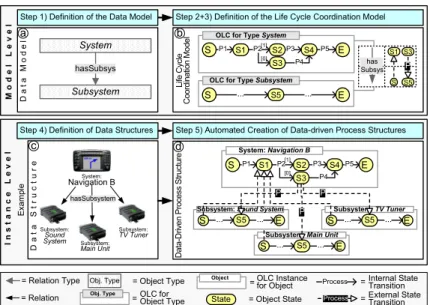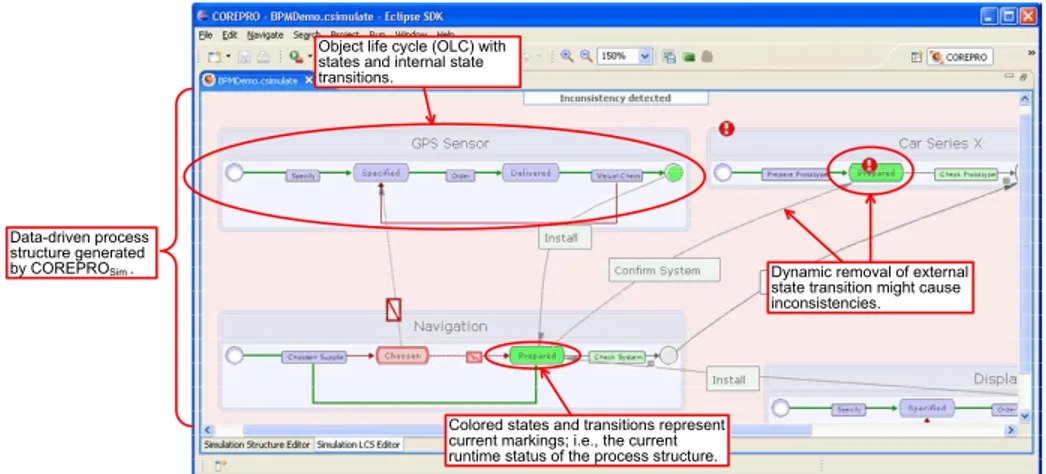COREPRO
Sim: A Tool for Modeling, Simulating and Adapting Data-driven Process Structures
?Dominic M¨uller1,2, Manfred Reichert1, Joachim Herbst2, Detlef K¨ontges1,2, and Andreas Neubert1
1 Institute of Databases and Information Systems, Ulm University, Germany {dominic.mueller, manfred.reichert, andreas.neubert}@uni-ulm.de
2 Dept. GR/EPD, Daimler AG Group Research & Advanced Engineering, Germany {joachim.j.herbst, detlef.koentges}@daimler.com
Abstract. Industry is increasingly demanding IT support for large en- gineering process structures consisting of hundreds up to thousands of synchronized processes. In technical domains, such process structures are characterized by their strong relation to the assembly of a product (e.g., a car); i.e., resulting process structures aredata-driven. The strong link- age between data and processes can be utilized for automatically creating process structures as well as for (dynamically) adapting them at a high level of abstraction. This paper presents the COREPROSim demonstra- tor which enables sophisticated support for modeling, coordinating and (dynamically) adapting data-driven process structures. COREPROSim
substantiates the COREPRO approach which provides a new paradigm for the integration of complex data and process structures.
1 Introduction
In the engineering domain, the development of complex products (e.g., cars) ne- cessitates the coordination of largeprocess structures. Managing such structures, however, is a complex task which is only rudimentarily supported by current workflow technology [1]. Process structures often show a strong linkage with the assembly of the product; i.e., the processes to be coordinated can be explicitly assigned to the different product components. Further, synchronizations of these processes are correlated with the relations existing between the product com- ponents. We denote such process structures asdata-driven. COREPRO utilizes information about product components and their relations for modeling, coordi- nating, and (dynamically) adapting process structures based on given (product) data structures. For example, the assembly of a (product) data structure can be used to automatically create the related process structure [2].
The adaptation of process structures constitutes a particular challenge. When adding or removing a car component (e.g., a navigation system), for example, the instantiated process structure has to be adapted accordingly; i.e., processes
?This work has been funded byDaimler AG Group Researchand has been conducted in theCOREPROproject (http://www.uni-ulm.de/dbis)
In: Proc. of International Conf. on Business Process Management (BPM 2008), pp. 394–397. LNCS 5240. Springer Verlag.
as well as synchronization relations between them have to be added or removed.
When changing a (product) data structure during runtime, in addition, the running process structure must be adapted on-the-fly, but without leading to faulty synchronizations (e.g. deadlocks). To cope with this challenge, again, our approach takes benefit from the strong linkage between process structure and (product) data structure. Data structure changes can be translated into con- sistent adaptations of the corresponding process structure [3]. Thus, changes of data-driven process structures can be introduced by users at a high level of abstraction, which reduces complexity as well as cost of change significantly.
This paper sketches COREPROSim – a demonstrator enabling the model- ing, enactment and (dynamic) adaptation of data-driven process structures. It enhances the COREPROM odeler, our first demonstrator supporting the manual modeling of data-driven process structures [4]. COREPROSimhas been realized using the Eclipse Graphical Editing Framework. It implements an instantiation concept for automatically creating data-driven process structures and a runtime framework for simulating them [2, 3]. Furthermore, COREPROSim translates (dynamic) changes of currently processed data structures into corresponding adaptations of the related process structures. Finally, consistency is checked to ensure that dynamic adaptations result again in a sound process structure.
2 COREPRO Framework and Demo Description
The COREPRO modeling framework considers the sequence of states a (data) object goes through during its lifetime. A car component, for example, passes states liketestedandreleased. Generally, state transitions are triggered when ex- ecuting the processes which modify the respective object (e.g.,testandrelease).
Anobject life cycle (OLC) then constitutes an integrated and user-friendly view on the states of a particular object and its manipulating processes (cf. Fig. 1b).
Based on a collection of OLCs and their synchronizations, large process struc- tures can be built. OLC state transitions do not only depend on the processes associated with the respective object, but also on the states and state transitions of other objects. As example consider a car prototype, which will be only tested if all subsystems (e.g., engine, chassis and navigation system) are tested before.
By connecting the states of different OLCs, a logical view on the data-driven process structure results (cf. Fig. 1d).
Five steps become necessary to create a data-driven process structure using COREPROSim (cf. Fig. 1). Step 1 deals with the specification of a domain- specificdata model, which defines object and relation types, and therefore consti- tutes the schema for instantiating concrete (product)data structures. An object type represents a class of objects within the data model (cf. Fig. 1a), which can be instantiated multiples times (cf. Fig. 1c).
Step 2 (cf. Fig. 1b) is related to the modeling of OLCs. Internally, OLCs are mapped tostate transition systemswhose states correspond to object states and whose (internal) state transitions are associated with object-specific processes.
Non-deterministic state transitions are realized by associating different internal
ModelLevelInstanceLevel
System hasSubsys
Subsystem
DataModel Life Cycle Coordination Model
has Subsys P
S3
S ... S5 ... E
OLC for Type Subsystem
Step 1) Definition of the Data Model Step 2+3) Definition of the Life Cycle Coordination Model
Step 5) Automated Creation of Data-driven Process Structures S S P1 S1 S4 P5 E S1
OLC for Type System
S3 P3
P4 [1]
[0]
S ... S5 ... E Subsystem: Main Unit S ... S5 ... E
Subsystem: Sound System hasSubsystem
System:
Navigation B
Subsystem:
Sound System Subsystem:
Main Unit Subsystem:
TV Tuner
DataStructure Data-Driven Process Structure
P2 S2
S P1 S1 S4P5 E System: Navigation B
S3 P3
P4 [1]
[0]
S2 P2
a b
c d
S5
S ... S5 ... E Subsystem: TV Tuner
Example
P P
P
State = Object State
Object OLC Instance
for Object Process = Internal State Transition
=
Process External State Transition
= Relation Type Obj. Type = Object Type
= Relation Obj. Type OLC for Object Type
=
= Step 4) Definition of Data Structures
Fig. 1.Procedure for Creating Data-Driven Process Structures
state transitions with same source state and process, and by adding a process result as condition (e.g.,P2with possible results0and1in Fig. 1b).
Step 3 deals with the state dependencies existing between the OLCs ofdif- ferent object types. In COREPRO, an OLC dependency is expressed in terms of external state transitions between concurrently enacted OLCs (which together form the process structure). Like an internal OLC state transition, an external state transition can be associated with the enactment of a process. To benefit from thestrong linkagebetween object relations and OLC dependencies, external state transitions are mapped to object relation types (cf. Fig. 1b).
Steps 4 + 5 are related to the instance level. COREPROSimallows to instan- tiate different data structures based on a given data model (cf. Fig. 1c) and to automatically create related process structures (cf. Fig. 1d). A data-driven pro- cess structure includes an OLC instance for every object from the data structure.
Likewise, as specified in Step 3, for each relation in the data structure external state transitions are added to the process structure; e.g., for everyhasSubsystem relation in the data structure from Fig. 1c, corresponding external state transi- tions are added (cf. Fig. 1d).
As result we obtain an executable process structure describing the dynamic aspects of the given data structure (cf. Fig. 1d). To ensure a correct dynamic behavior, COREPROSimallows for checking soundness of the process structure based on the concepts described in [2].
When simulating data-driven process structures, COREPROSim uses differ- entmarkingsto reflect the current runtime status (cf. Fig. 2). We annotate states as well as (internal and external) state transitions with respective markings. By analyzing state markings, for example, we can immediately figure out whether
Dynamic removal of external state transition might cause inconsistencies.
Object life cycle (OLC) with states and internal state transitions.
Colored states and transitions represent current markings; i.e., the current runtime status of the process structure.
Data-driven process structure generated by COREPROSim .
Fig. 2.Simulation and Dynamic Change of Process Structure with COREPROSim
a particular state of a process structure has been already passed, is currently activated, has been skipped, or has not been reached yet. Transition markings, in turn, indicate whether the associated process has been started, skipped or completed. The use of markings further eases consistency checking and runtime status adaptations in the context of dynamic changes of process structures.
To cope with flexibility requirements of engineering processes, we allow users (e.g., engineers) to perform dynamic process structure adaptations. In COREPROSim, this is accomplished by automatically translating changes of the data structure (cf. Fig. 1c) into adaptations of the respective process structure [3]. Removing an object, for example, leads to the removal of the related OLC.
Such dynamic adaptations must not violate soundness of the process structure.
To ensure this, COREPROSimconstrains changes to certain runtime states (i.e., markings) of the process structure (cf. Fig. 2).
In summary, COREPROSim constitutes a powerful demonstrator realizing the concepts developed in the COREPRO project [1–3]. It is currently applied in the context of a case study in the automotive industry. In future, we will extend the current prototype with extensive mechanisms for runtime exception handling and integrate existing data sources and applications.
References
1. M¨uller, D., Herbst, J., Hammori, M., Reichert, M.: IT support for release manage- ment processes in the automotive industry. In: BPM. LNCS 4102 (2006) 368–377 2. M¨uller, D., Reichert, M., Herbst, J.: Data-driven modeling and coordination of large
process structures. In: CoopIS. LNCS 4803 (2007) 131–147
3. M¨uller, D., Reichert, M., Herbst, J.: A new paradigm for the enactment and dynamic adaptation of data-driven process structures. In: CAiSE. LNCS 5074 (2008) 48–63 4. M¨uller, D., Reichert, M., Herbst, J., Poppa, F.: Data-driven design of engineering
processes with COREPROM odeler. In: WETICE’07, IEEE (2007) 376–378

